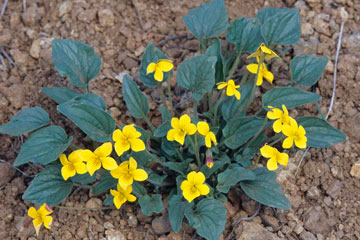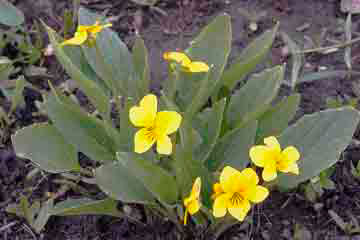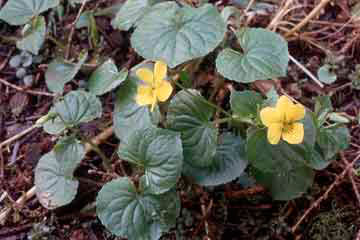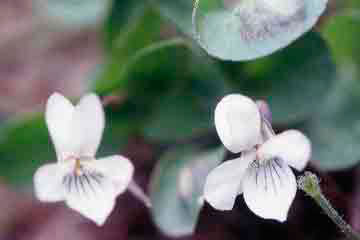Home | Next |
Previous | Index |
Purchase book
Idaho Mountain Wildflowers
Violet Family, Violaceae
Violets, wild and cultivated, have been treasured for millennia. The
violet family is made up of 23 genera and 900 species. (African violets,
Saintpaulia spp., are members of another family, Gesneriaceae.) Most
are found in the north temperate zone. About sixty species are native to
the United States, and about half a dozen grow in our mountains. The name
“violet” was derived from the Latin word viola, for a sweet
smelling flower, possibly the European violet, Viola odorata L., a
small pansy-like flower known to Europeans as “hearts-ease,” and
to us as “Johnny-jump-up,” believed to be an ancestor of today’s
cultivated pansies. Violets have five sepals and five separated petals. The
flowers are irregular but bilaterally symmetrical, with a large, sometimes
bearded, lower petal. A nectar-containing sac or spur attached to the lower
petal may extend backward behind the flower. Most violets prefer shade and
moisture, but some, like our upland yellow violet, Viola praemorsa,
flourish on dry ground. Violets tend to be spring bloomers, recognizing that
“spring” for flowers represents a condition rather than a date,
and varies with altitude. Some species may flower again in the fall if the
weather is mild.
 |
The following two yellow violets have, confusingly, been reclassified
recently .
Upland yellow violet, Viola praemorsa
Douglas ex Lindl. var. linguifolia M.S. Baker & J. C.
Clausen ex M. E. Peck (left). The plant shown, known locally
as the goosefoot violet, Viola purpurea Kellogg, is now considered
to be a variety of the upland yellow violet. It is commonly seen growing
in the company of sagebrush. The lower petal has purplish-brown pencilling
and the underside of the petals may be a purplish-brown color. The plant
is one of the earliest flowers to bloom in the spring, appearing immediately
after snow-melt on seemingly dry, gravelly soil, flowering at ever higher
elevations as high as the subalpine zone.
Valley violet, Viola vallicola A.
Nelson (right). Previously known as Nuttall’s violet
(Viola nuttallii Pursh), the valley violet is distinguished by its
large lanceolate leaves. These may be smooth-edged, or have shallow teeth
. The plant grows from mid- to high elevations in our mountains, always
along stream banks and on moist ground. |
 |
 |
Pioneer violet, Viola glabella
Nutt. (left). The pioneer, or stream violet, appears in
great numbers in the northern half of Idaho, preferring the moist ground
of deep woods and streambanks. It may be identified by bright yellow flowers
marked with black pencilling, and heart- or kidney-shaped leaves. The plant
was collected first by Thomas Nuttall in the coastal mountains of Oregon
in the spring of 1835.
Hooked violet, Viola adunca Sm.
(right). If, in hiking along muddy trails and through
spring-moist meadows, you see blue violets, they are, in Idaho, Viola
adunca, the hooked violet (also early blue violet). Look closely at the
flower and you will see that it has an upward turning spur behind the upper
petals; this is derived from part of the lower central petal. The name,
adunca, means “hook” in Latin. |
 |
 |
Small white violet, Viola
macloskeyi F. E. Lloyd. The
common name “small white violet” suits this plant, for its
purple-marked flowers are the smallest of any of our violets. The plants
grow from mid-elevations to high in our mountains, blooming in moist places.
The little flowers are usually tangled up in a mat of variable, kidney and
heart-shaped leaves making them hard to photograph. Two varieties are recognized,
one with scalloped leaves, var. pallens (Hanks ex Ging.) C.L. Hitch.,
and the other with smooth-edged leaves, var. macloskeyi. The latter
is said not to occur in Idaho, although those shown here fit the description
of that variety. George Macloskey (1834-1920), was born in Ireland. and became
professor of biology at Princeton (1874-1906). |
Home | Next |
Previous | Index |
Purchase book




